The flagship Android segment has always been a battlefield but you
wouldn't want to be around when these two are in their most violent
mood. The Samsung Galaxy S5 and Sony Xperia Z2 are two of the most
advanced smartphones to ever sit on a store shelf. Both make big claims
regarding screens and cameras (staples for both companies) and brag
about practically each of their features. And to say that it's a long
list would be a massive understatement.

Samsung is in its prime, in large part due to the enormous commercial
success of its phones. Sony is ailing and cutting off businesses to
focus more tightly on its core competencies, especially smartphones. The
outcome of this matchup will have a great impact on the fates of the
two tech giants.
Here's a quick blow by blow of where each phone bests its opponent.
Keep in mind those differences are on paper only and the advantage might
shift from one side to the other in the actual tests.
Galaxy S5 over Xperia Z2
- Screen with great color accuracy, better sunlight legibility
- Higher CPU clockspeed - 2.5GHz vs. 2.3GHz
- More compact, lighter
- Faster phase-detection autofocus (just 0.3s to lock)
- Fingerprint scanner, PayPal certified
- Heart rate sensor
- IR blaster
- Better ingress protection - IP67, dust tight
- Faster USB - v3.0 vs. v2.0
- 32GB of built-in storage is an option
Xperia Z2 over Galaxy S5
- Bigger, higher resolution camera sensor - 1/2.3" 20.7MP vs. 1/2.6" 16MP
- Higher water resistance level - IP58, immersion beyond 1m
- More RAM - 3GB vs. 2GB
- Stereo speakers
- Slightly bigger screen - 5.2" vs. 5.1"
- Bigger battery - 3,200mAh vs. 2,800mAh
- Newer MHL version - 3.0 vs. 2.1
Sony and Samsung are competing in the camera market - from
point-and-shoot through mirrorless to DSLR - so of course they put their
own sensors in their flagship phones. Smartphones have been outselling
traditional cameras for years now.
The two companies are also among the biggest TV makers and some of
the biggest display makers for screens big and small. You can bet your
bottom dollar their flagship phones are going to serve as a promotion of
the two respective screen business.
Sony made water resistance a trademark for the flagship Xperia
devices, but this year Samsung jumped on it too after dabbling with
Xcover and Active devices.



 Samsung Galaxy S5 and Sony Xperia Z2, ready to face off
Samsung Galaxy S5 and Sony Xperia Z2, ready to face off
One way or another, flagship smartphones have become the calling
cards, pocket-sized posters of the companies that make them. With good
reason too, no other digital segment sells in the hundreds of millions
units and keeps growing year after year. In fact, cameras, TVs even
computers are in decline.
So it should come as no surprise that the two tech giants are putting
on their Sunday best for the two flagships - that means the best
screen, camera, chipset and other goodies they could get their hands on,
plus the best design they could dream up.
User interface
The Samsung Galaxy S5 and Sony Xperia Z2 both launch with Android
4.4.2 KitKat out of the box with a number of software tweaks by each
parent company. As usual, Sony's skin is lighter while Samsung is
typically modding stock Android head to toe.
Samsung is into biometric sensors this generation and the fingerprint
sensor on the Home key is a highlight. This enables a secure lockscreen
that isn't based on passwords or patterns, instead you swipe a finger
down the key. In case it fails (it happens when your fingers are wet,
for example), then it falls back to a passcode so there's no danger of
getting locked out.


 The TouchWiz lockscreen is enhanced by the fingerprint scanner
The TouchWiz lockscreen is enhanced by the fingerprint scanner
Sony stayed closer to the vanilla lockscreen, the only real change is
the camera shortcut at the bottom. The Xperia Z2 lockscreen supports
widgets (one per pane), while the Samsung screen only shows
notifications.
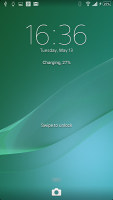

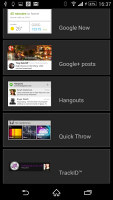
 Near-stock lockscreen on the Xperia Z2
Near-stock lockscreen on the Xperia Z2
The Sony home screen is also very vanilla - you start with 5 panes
and you can add or remove panes. One Sony addition is Themes, which pack
a wallpaper and matching color highlights for UI elements.
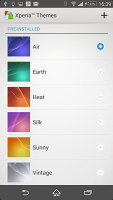 Themes make for quick and easy customization
Themes make for quick and easy customization
Samsung's homescreen looks fairly standard except the My Magazine
feature replaces one of the homescreen panes. It's a news reader that
will pull news and content from multiple sources in several categories
and your social networking accounts.



 My Magazine melds social networking with news reading
My Magazine melds social networking with news reading
Sony has Socialife, which is an app instead. It merges Facebook and
Twitter accounts with news sources, but doesn't take up an entire
homescreen pane.
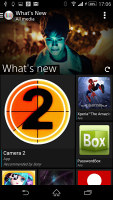


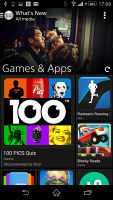 What's new is Sony's answer to Samsung's My Magazine and HTC's Blinkfeed
What's new is Sony's answer to Samsung's My Magazine and HTC's Blinkfeed
In contrast with the minimalist lockscreen, Samsung stuffed the
notification area with features. Some of them we like - the quick
toggles and brightness slider are used often enough to warrant a place
here. The S Finder and Quick Connect buttons are debatable.
Another like that pops up here is Recommended apps. It's a response
to certain events, e.g. plugging in a pair of headphones brings out
shortcuts for multimedia apps.



 A somewhat cluttered TouchWiz notification area • Recommended apps
A somewhat cluttered TouchWiz notification area • Recommended apps
Sony's notification area looks more stock but Sony did put tabs on it
to separate the notifications from the toggles. The toggles themselves
include some Sony additions like the Stamina mode.

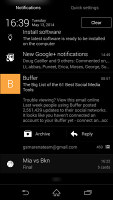
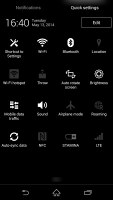 Xperia's cleaner notification area differs only slightly from vanilla Android
Xperia's cleaner notification area differs only slightly from vanilla Android
The fingerprint sensor on the Samsung Galaxy S5 isn't limited to the
lockscreen - in the co-called Private mode, it secures files (photos,
videos, documents) in an encrypted part of the phone's storage. They are
only visible when Private mode is on, which takes a swipe of a finger.
The sensor can also secure payments with PayPal. You can set up to
three fingers to be recognized, so you can share the phone with someone
and let them access Private mode and PayPal payments or keep those to
yourself.



 Activating private mode • moving photos to the secure storage
Activating private mode • moving photos to the secure storage
For multitasking, Samsung pushes its Multi Window feature that puts
two apps side by side. You can copy and paste text between them or snap a
screenshot in one and use it in the other. Apps that go well together
can be grouped into a single shortcut for added convenience.



 Multi Window runs two apps side by side
Multi Window runs two apps side by side
Sony has its own multitasking feature, Small Apps. Instead of
splitting the screen, Small apps live in small windows that can be moved
around or minimized to a tiny icon. Like Multi Window, you need an app
that specifically supports the multitasking feature, but Sony's solution
can turn widgets into Small apps.
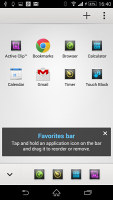
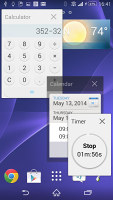
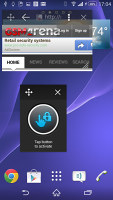 Small apps put helpful tools in floating windows
Small apps put helpful tools in floating windows
The two approaches are not really compatible. Samsung's approach
assumes both apps are equal, while Sony's has one main app and one
utility app.
Winner: Samsung Galaxy S5. We know TouchWiz has its vocal
detractors, but no one can deny its wealth of features and a good deal
of those are pretty helpful in your day-to-day operations. The Xperia Z2
is right up there with it, but the fingerprint scanner enables an extra
lockscreen option and secure storage. Multi Window is more elaborate
than Small apps too.
Source








































 Motorola
Motorola 

















































